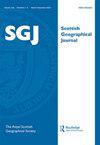阿伯丁郡仪式景观调查:与金星有关的人类祭祀遗址
IF 2
4区 社会学
Q2 GEOGRAPHY
引用次数: 1
摘要
摘要:在阿伯丁郡芬特雷的哈顿附近,一组肉眼可见的史前纪念碑描绘了102公里的仪式景观。当从另一个角度观察时,它们充当着太阳和月球地平线上升和设置极端的背光灯。当地神的身份融合为教区圣徒,这是一种与前基督教爱尔兰酋长的民族志类比,也是一种口头传统,即其中一座纪念碑Gouk Stone(古英语中“杜鹃”的意思)标记了该名称的“将军”被杀的地点,这支持了当地酋长,以这只鸟的名字命名,并与当地化身为金星的主权女神“结婚”,绑在石头上并进行仪式性祭祀。这发生在具有文化意义的Samhain日,从青铜时代到铁器时代晚期,间隔八年。这段时间恰逢金星在Samhain的极端夜晚。为了支持这一假设,这块石头充当了金星在Samhain几天内出现极端情况的地平线展望,并充当了Samhain石圈后面日落的后视。地名表明该地点在中世纪之前一直是集会/司法场所。本文章由计算机程序翻译,如有差异,请以英文原文为准。
An investigation of an Aberdeenshire ritual landscape: a site of human sacrifice associated with Venus
ABSTRACT A group of intervisible prehistoric monuments delineate a ritual landscape of 102 kilometres near Hatton of Fintray, Aberdeenshire. They act as back and foresights on solar and lunar horizon rising and setting extremes when viewed one from another. The identities of the local deities, syncretised as parish saints, an ethnographic analogy with pre-Christian Irish chieftains and an oral tradition that one of the monuments, the Gouk Stone (Old English for ‘cuckoo’), marks the location where a ‘general’ of that name was slain, support the hypothesis that local chieftains, titled after the bird and ‘married’ to the local goddess of sovereignty that personified Venus, were tied to the stone and ritually sacrificed. This occurred on the culturally significant day of Samhain at eight-year intervals from the Bronze Age until the late Iron Age. The interval coincided with the extreme evening setting of Venus at Samhain. In support of this hypothesis the stone acted as a horizon foresight for Venus setting extremes which occurred within a few days of Samhain and as a back sight with sunset behind a stone circle on Samhain. Place-names indicate the location remained an assembly/judicial site until the Medieval Period.
求助全文
通过发布文献求助,成功后即可免费获取论文全文。
去求助
来源期刊

Scottish Geographical Journal
GEOGRAPHY-
CiteScore
1.80
自引率
20.00%
发文量
19
期刊介绍:
The Scottish Geographical Journal is the learned publication of the Royal Scottish Geographical Society and is a continuation of the Scottish Geographical Magazine, first published in 1885. The Journal was relaunched in its present format in 1999. The Journal is international in outlook and publishes scholarly articles of original research from any branch of geography and on any part of the world, while at the same time maintaining a distinctive interest in and concern with issues relating to Scotland. “The Scottish Geographical Journal mixes physical and human geography in a way that no other international journal does. It deploys a long heritage of geography in Scotland to address the most pressing issues of today."
 求助内容:
求助内容: 应助结果提醒方式:
应助结果提醒方式:


